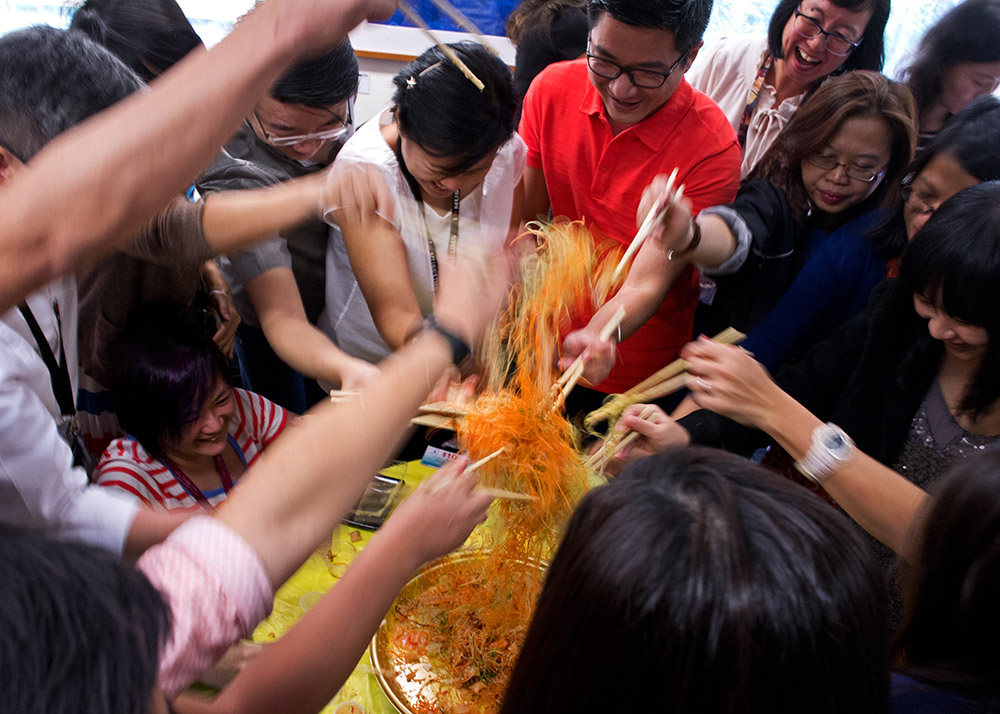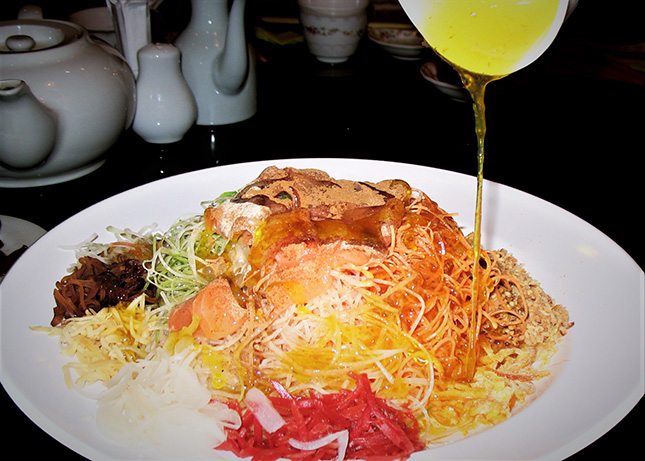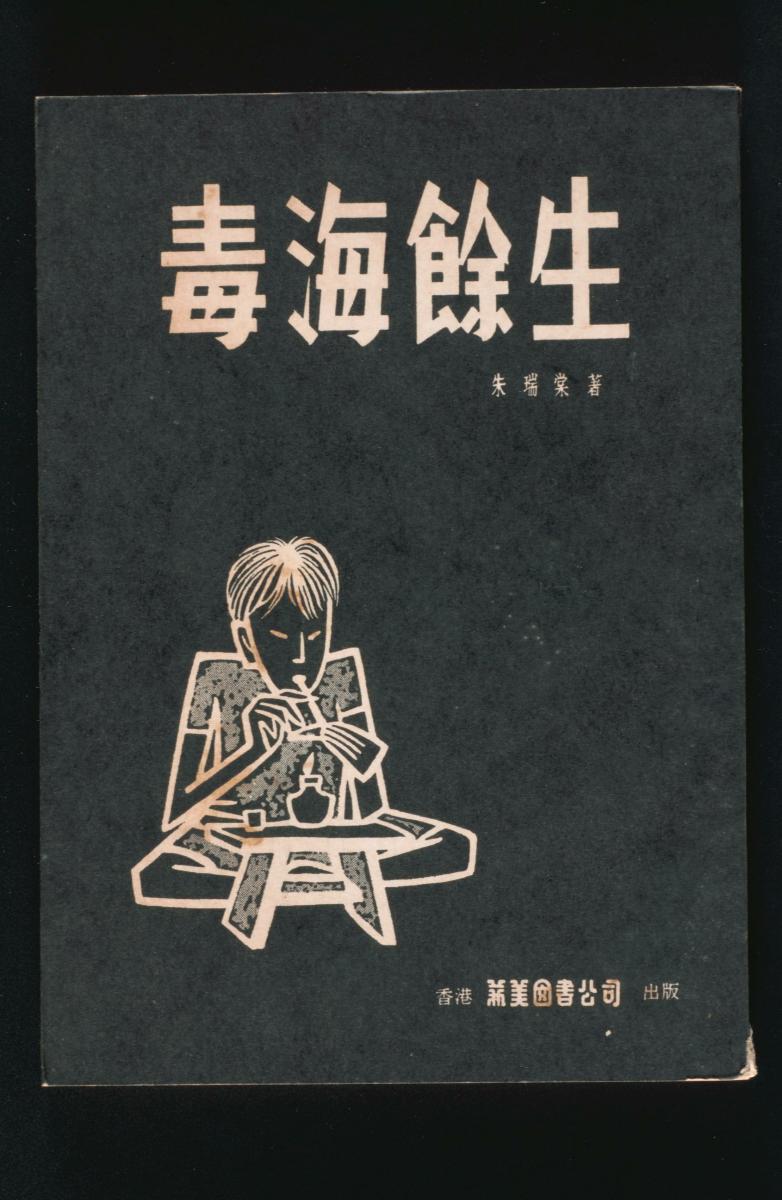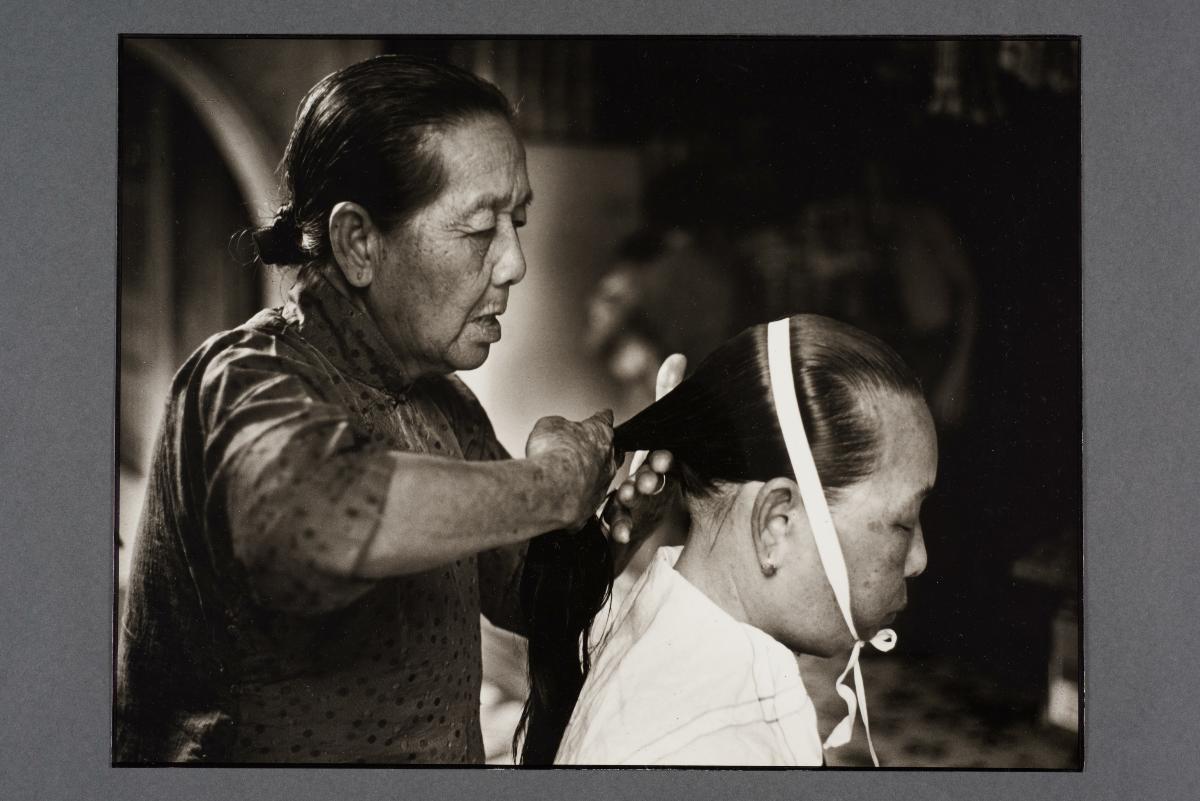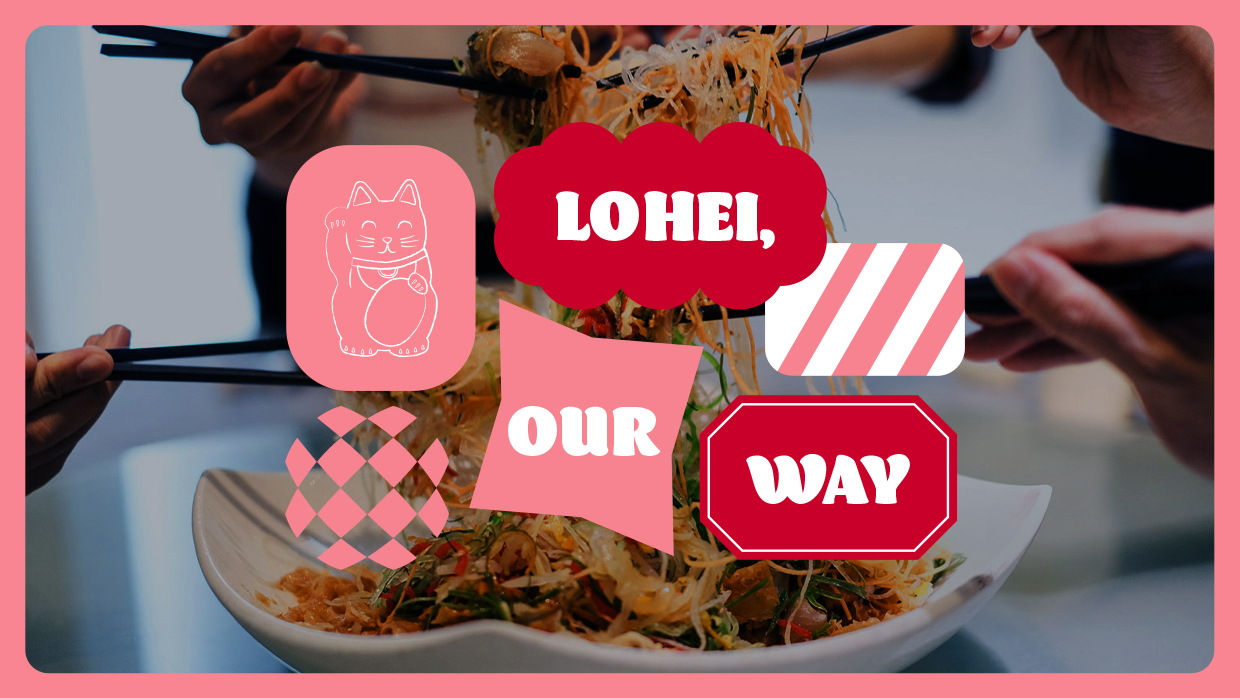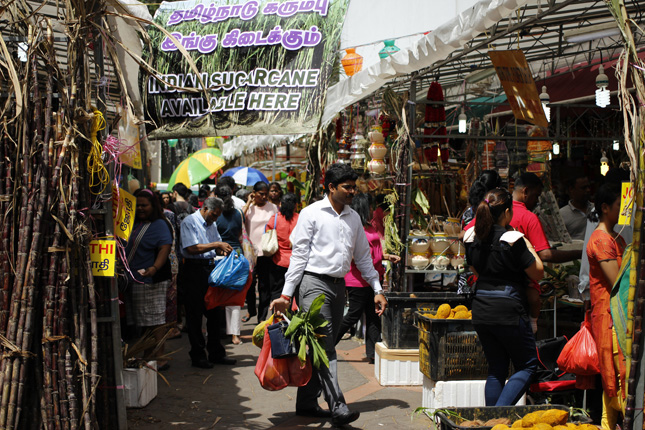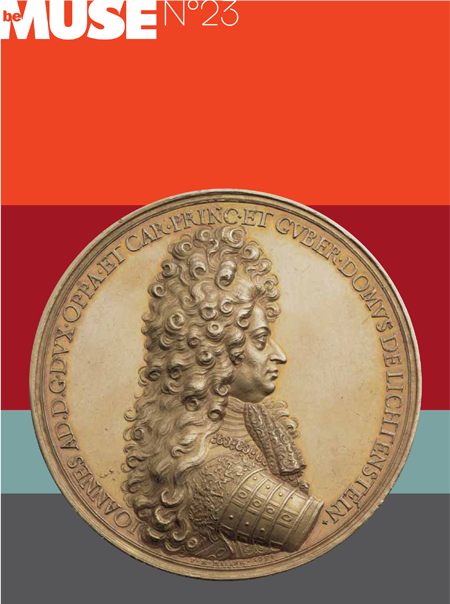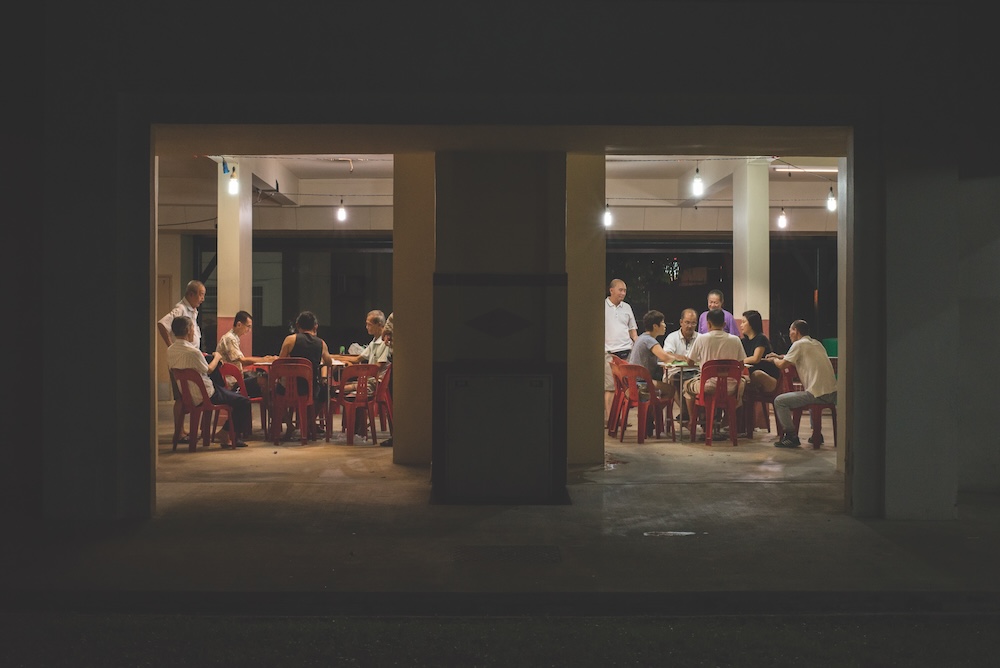Yusheng and Lo Hei
Lo hei 捞起 (Cantonese for ‘tossing up’) refers to the communal tossing of yusheng 鱼生, a dish comprising fish slices, vegetables, spices and condiments. Traditionally, the practice was commonly observed on Renri 人日, the seventh day of the first lunar month. Today, people can enjoy yusheng throughout the entire Chinese New Year period. Oftentimes, non-Chinese are also invited to participate in this festive activity, which symbolises togetherness and the hope for good fortune in the coming year.
A key ingredient in yusheng, raw fish has been part of the Chinese culinary culture from as early as the Zhou Dynasty (circa 1046 BC–256 BC). By the end of the Qing Dynasty (1644–1911), the consumption of raw fish slices was largely limited to the southern Chinese province of Guangdong and the Chaoshan region. Cantonese and Teochew immigrants introduced the yusheng dish to Singapore and Malaysia in the 19th century.
The original yusheng was simple and had relatively few ingredients: raw fish, cucumber, radish and coriander were topped with vinegar, oil and sugar. The current colourful variation of the dish that is familiar to Singaporeans is known as the Qi Cai Yusheng 七彩鱼生 (‘Seven-Coloured Yusheng’). Many believe that the dish was adapted into its present familiar form by then-chef apprentices Sin Leong, Hooi Kok Wai, Tham Yui Kai and Lau Yoke Pui; the same four were later dubbed the ‘Four Heavenly Kings’ of Singapore’s culinary scene in the 1960s and 1970s. This new yusheng made its debut on the second day of Lunar New Year in 1964.
Others trace the origin of the modern-day yusheng to Loke Ching Fatt, a Chinese immigrant who settled in the Malaysian town of Seremban. He was said to have introduced his own colourful interpretation and multi-ingredient version of the traditional yusheng – the Sup Kum Yee Sang 十感鱼生 (‘Tenth Sense Yusheng’ in Cantonese) – in the 1940s.
Geographic Location
Besides Singapore, lo hei is also widely practised in Malaysia during the Chinese New Year period. While many choose to toss yusheng in Chinese restaurants, others prefer to do it at home, purchasing pre-packaged yusheng from food stalls or supermarkets, or making their own from scratch.
Communities Involved
Even though it is traditionally a Chinese custom, lo hei is also enjoyed by many from other communities. Different variations to yusheng – including vegetarian and halal ones – are available today to cater to the different dietary needs of people. Most Chinese restaurants offer the dish during the Chinese New Year period, and waitstaff are usually able to recite the auspicious phrases that set the stage for lo hei.
Associated Social and Cultural Practices
The term yusheng can be understood literally as ‘raw fish’ in Mandarin Chinese. However, yu 鱼 (‘fish’) is also a homophone to yu 余 (‘abundance’), while sheng 生 (‘raw’) shares the same character and pronunciation as sheng 生 (‘growth’, ‘life’); together, the name of the dish also implies an increase in abundance and conveys the wish of prosperity and long life.
Propitious phrases are recited when the ingredients are added on to the tossing plate. the addition of each ingredient onto the plate. All the ingredients used in yusheng have special and auspicious meanings. As mentioned, the fish slices symbolise abundance in the coming year. Among others, pomelo shreds and shredded carrot stand for good luck and prosperity; the golden ground peanuts, deep-fried flour crisps and dash of oil are associated with great wealth and profits; shredded green radish holds the meaning of youthful beauty; a drizzle of honey signifies sweetness and bliss; and a squeeze of lime and a sprinkle of five-spiced powder represent blessings for all those present.
When all the ingredients are prepared and placed on the plate, people gather and stand around the table, symbolising togetherness, unity and harmony. With chopsticks in their hands, they toss the ingredients and utter auspicious phrases simultaneously, expressing their wishes and hopes for the coming year. It is believed that the higher one tosses the ingredients, the greater fortune he or she will enjoy in the coming year. Thereafter, everyone consumes the yusheng. Apart from being a family affair, lo hei is also often practised among friends and colleagues.
For some, lo hei has become a ritualised culinary experience. The following shows a step-by-step of how lo hei could be carried out and the phrases to be said:
Experience of a Practitioner
Lai Wah Restaurant was started in 1963 by Wong Kok Lum and two of ‘Four Heavenly Kings’ of Singapore’s Cantonese cuisine, Tham Yui Kai and Lau Yoke Pui. Wong’s eldest son, Wong Kah Onn, inherited the restaurant when his father passed away. When the restaurant first opened for business, yusheng was one of the items on the menu. Mr Wong Kah Onn recalls that the practice of lo hei in the restaurant came about because customers had asked waitstaff to introduce individual ingredients in the yusheng and to match an auspicious greeting to each one of them. The diners would then toss the ingredients together.
For Mr Wong, he identifies lo hei with his Chinese heritage. He believes that the tradition of lo hei, with its associated practices and significance, contributes to the diverse cultural heritage landscape in Singapore.
Present Status
Lo hei has since become an integral part of Chinese New Year celebrations in Singapore and will continue to be a valued tradition in Chinese homes and restaurants. New spins to the traditional dish have also appeared on the market in recent years, such as Italian, Thai, Japanese and Sichuan yusheng, to suit different preferences, especially those from the younger generations.
References
Reference No.: ICH- 096
Date of Inclusion: November 2020
References:
Anonymous. ‘Try Some Salmon Yu Sheng’. The Straits Times. 29 January 1984. http://eresources.nlb.gov.sg/newspapers/Digitised/Article/straitstimes19840129-1.2.125.21.4.2. Accessed 10 September 2020.
Anonymous. ‘Where You Can Find Luck – In the Form of Raw Fish’. The Straits Times. 10 February 1980. http://eresources.nlb.gov.sg/newspapers/Digitised/Article/straitstimes19800210-1.2.70.10. Accessed 10 September 2020.
Chen, Jingwen. ‘Tossing for Luck: A Guide to Safe, Mouthwatering Yusheng Creations’. AsiaOne. 26 January 2017. http://www.asiaone.com/food/tossing-luck-guide-safe-mouthwatering-yusheng-creations. Accessed 6 December 2017.
Cheng, C. S. ‘Fa Cai Yusheng – A Singapore Original’. The Straits Times (Singapore). 17 January 1993, 7.
Huang, Lijie. ‘It’s a Toss Up’. ST Foodies Club. 9 February 2008. https://web.archive.org/web/20080209122108/http://www.stomp.com.sg/stfoodiesclub/taste/115/index.html. Accessed 10 September 2020.
Mendoza, Don. ‘What to Do if There’s No Raw Fish in the Yusheng?’. TODAYonline. 14 January 2016. http://www.todayonline.com/lifestyle/food/what-do-if-theres-no-raw-fish-yu-sheng. Accessed 6 December 2017.
Ng, Jing Yng. ‘Yusheng: From Roadside Fare to Chinese New Year Must-Have’, TODAYonline. 13 January 2016. http://www.todayonline.com/singapore/yusheng-roadside-fare-chinese-new-year-must-have. Accessed 6 December 2017.
Tan, Bonny, Rakunathan Narayanan, and Lee Meiyu. ‘Yusheng’. Infopedia. n.d. http://eresources.nlb.gov.sg/infopedia/articles/SIP_177__2009-01-08.html. Accessed 6 December 2017.
Tan, Judy. ‘Make the Salad Yourself’. The Straits Times (Singapore). 29 January 1987, 20.
Tay, Leslie. ‘The History and Origins of Yu Sheng: An Editorial’. I Eat I Shoot I Post (blog). 17 February 2012. http://ieatishootipost.sg/the-history-and-origins-of-yu-sheng-an-editorial/. Accessed 6 December 2017.




